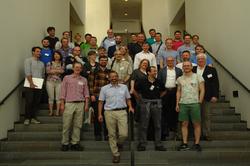Forum on Advances FEL Techniques
Forum on Advanced FEL Techniques in Stockholm 2018, 27-28 June
The Forum, being a Satellite event to the Science@FEL conference, gathered around 40 participants in a sunny and warm Stockholm with a distracting football event ever present.
Within Science@FEL the Forum is a key action in the exploration of FEL techniques and FEL user possibilities, especially joining the forces for an even more focused future development.
The Forum focused on bringing together FEL developers and Users, aiming at improving exchanges between the two communities. Plenty of time was therefore used for discussions that were introduced by review and highlight talks where users and FEL developers presented side-by-side, dedicated to important aspects such as coherence, photon pulse manipulation, high pulse energy, polarization control, ultrashort pulses, and production of multiple colour pulses.
Discussions soon deepened in how to match the broad-range of community-dependent requirements to different techniques available by FEL developments both in the soft and hard X-ray regimes.
Users pointed to the key characteristics of FEL pulses needed to fulfil experimental expectations. A large ensemble of users deal with time-resolved pump-probe experiments and are interested in relatively short pulses (down to a couple of femtoseconds) with well-synchronized and carrier-envelope stable pump-probe pulses over a large frequency range, from THz to optical and beyond. Timing, as an alternative to synchronization, is an option for some, while others see it as a work-around, difficult to conjugate to a large frequency-range of pumps, due to the need of dedicated timing tools at different frequencies.
Going towards single-particle imaging requires few-femtosecond pulses as well, but needs a large number of photons (Terawatt range) and shorter wavelengths allowing for sub-nm resolution. Studying ultra-fast phenomena goes even further, to sub-femtosecond single- or multi-pulses.
Applications dealing with warm and hot dense matter need mJ-level pulses with micrometer-size focus, while beams with stable and good degree of polarization are required for imaging magnetic domains. Finally, multiple-colour, high-repetition X-ray pulses are needed for site-selective, coincidence pump-probe experiments.
Another developing field discussed was OAM (Optical Angular Momentum) beams that can be created in FELs with helical undulators and how and if they can explored. Moving particles by light was shown (not only inspired by Scottish folk music as presented by Brian McNeil).
Users were asked to dream, what is the “dream beam”? Perhaps it cannot be created, not in a single machine, but sometimes the FEL developers come up with new surprising schemes as the FEL is among the most versatile light sources out there.
It was proposed to continue and deepen communication between users and developers both by an electronic platform, where requirements can meet FEL development ideas, and future Fora.
The Forum was generously hosted by Stockholm University.
Forum on Advanced FEL Techniques
Gianluca Geloni (European XFEL), Luca Giannessi (Fermi) and Sverker Werin (MAX IV)

